Spider mites, scientifically known as Tetranychidae, are tiny arachnids notorious for their destructive impact on indoor plants. These mites, which are less than 1mm in size, are often invisible to the naked eye, but their damage is unmistakable. According to a study published in the Journal of Economic Entomology, spider mites can infest over 200 species of plants, causing significant damage by sucking the sap out of the plant cells.
Indoor plants, with their controlled environment, often provide the perfect conditions for these pests to thrive. The dry, warm conditions of many homes, especially during winter months when heating systems are in use, can lead to rapid multiplication of these mites.
This guide aims to provide comprehensive insights into spider mite infestations – how to identify them, prevent them, and most importantly, how to get rid of them. From natural methods to chemical solutions, we’ll explore the most effective strategies to ensure your indoor garden remains healthy and mite-free.
What are Spider Mites and Why are They a Problem for Indoor Plants?
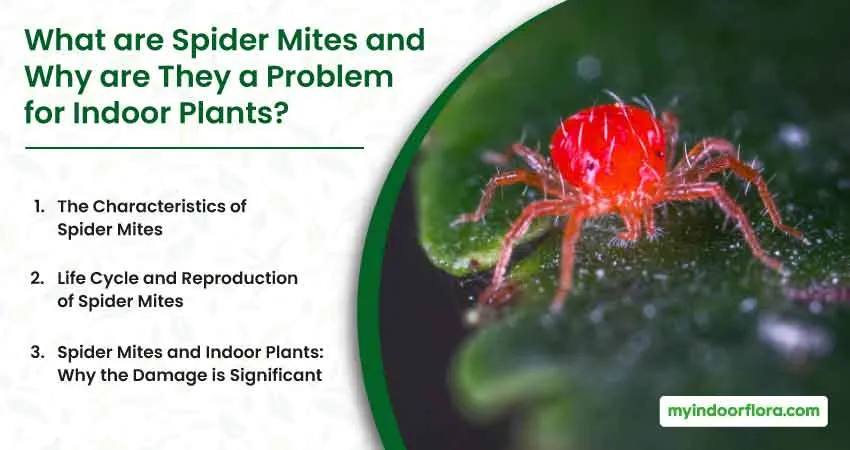
Spider mites, despite their name, are not actual spiders. They belong to the Acari (mite) family Tetranychidae, which contains over 1,200 species. Incredibly tiny, a fully grown spider mite is barely a millimeter long, which makes it nearly invisible to the naked eye.
However, what they lack in size, they make up for in the magnitude of destruction they can cause to plants. But how do these minuscule creatures cause such extensive damage?
The Characteristics of Spider Mites
Spider mites are oval-shaped creatures. They can appear in a variety of colors including red, green, yellow, or brown depending on their species and what they’ve been eating. Under a magnifying glass, they appear to have two dark spots on the sides of their bodies.
But, these pests don’t operate alone. A single female can lay hundreds of eggs in her two to four-week lifespan. That’s an enormous potential for infestation right there.
Life Cycle and Reproduction of Spider Mites
Spider mites have a rapid life cycle, which can result in an explosive increase in their population in a short time. Under favorable conditions (approximately 27°C/80°F), spider mites can complete their development from egg to adult in just 5-7 days!
Eggs hatch into larvae, which then transform into nymphs. After passing through two nymph stages, they develop into adults. During these stages, spider mites feed relentlessly, piercing plant cells to suck out their contents.
Spider Mites and Indoor Plants: Why the Damage is Significant
So, what makes them so detrimental to your indoor plants? Well, when they feed, they pierce the plant cells to suck out the nutrients. This not only weakens the plant but also disrupts its ability to photosynthesize efficiently. As a result, the leaves turn yellow, and the plant eventually wilts. If not controlled, an infestation can lead to the death of the plant.
It’s clear that spider mites pose a serious risk to your indoor plants. Let’s now dig into how they end up there in the first place.
How Do Spider Mites Get on Indoor Plants?
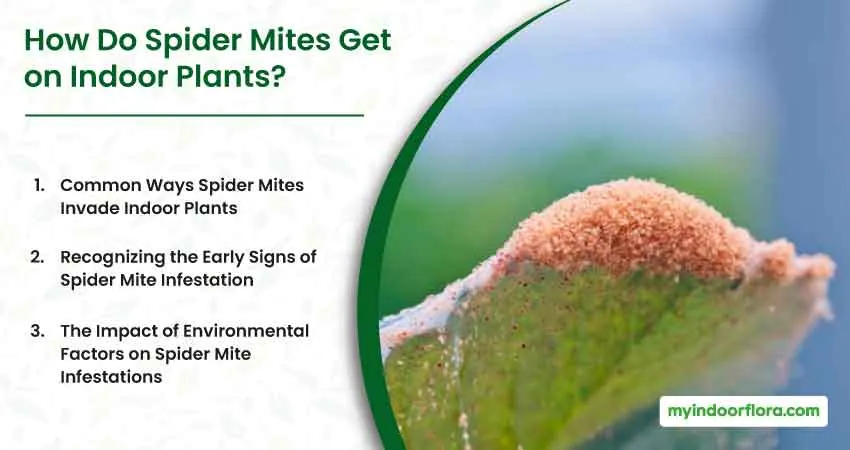
You might be thinking, “I haven’t brought any new plants home, so how did spider mites invade my indoor garden?” Well, these pesky invaders have several ways of gaining entry.
Common Ways Spider Mites Invade Indoor Plants
First, they could’ve hitched a ride on your clothes or pets from the outdoors. Yes, as much as we love a stroll in the park or a game of fetch, we could unwittingly bring back unwanted guests.
Second, if you’ve recently acquired a new plant, it could’ve already been carrying spider mites. Often, these mites can lay dormant in the soil or hide in the nooks of the plant, making it hard to notice them.
Lastly, if you have plants outside that are infested, they can easily make their way inside through open windows or doors.
Recognizing the Early Signs of Spider Mite Infestation
Before things spiral out of control, there are usually early warning signs. You may see small yellow or brown spots on the leaves, or find the plant has a dull, unhealthy look.
If you notice fine, silky webs on the underside of leaves or between stems, that’s a definite giveaway. The webs serve as protection against predators and facilitate their rapid spread across the plant.
The Impact of Environmental Factors on Spider Mite Infestations
It’s also important to note that spider mites thrive in dry and warm conditions. As such, indoor plants are especially vulnerable during winter when the heating systems are on, creating an ideal breeding environment for these pests.
Knowing how they get in and the signs to look for is the first step to safeguarding your indoor garden. But how can you confirm your suspicion of an infestation?
How Can You Confirm a Spider Mite Infestation in Your Indoor Plants?
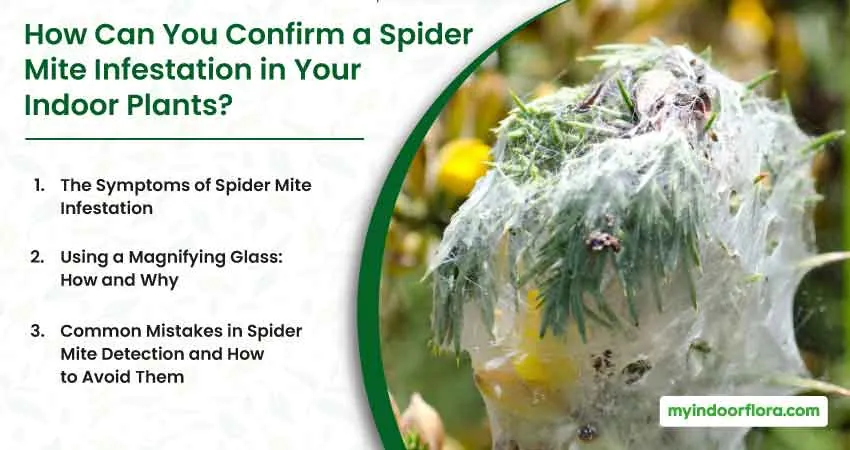
While the initial signs might be easy to overlook or even mistake for other plant ailments, there are specific ways to confirm a spider mite infestation.
The Symptoms of Spider Mite Infestation
Symptoms vary based on the extent of the infestation. Early signs include tiny yellow or white spots appearing on leaves, a result of the mites sucking out the chlorophyll. You might also notice a subtle, off-color hue on the plant.
As the infestation grows, leaves may become completely discolored, curl, and fall off. In severe cases, the plant may appear scorched, as though burned by heat or chemicals.
Using a Magnifying Glass: How and Why
Given their minuscule size, a hand lens or magnifying glass is often needed to see spider mites. When you hold a magnifying glass up to the underside of a leaf, you might see tiny moving specks. If you notice them along with the telltale webbing, there’s a high chance your plant is dealing with a spider mite infestation.
Common Mistakes in Spider Mite Detection and How to Avoid Them
One common mistake is to overlook an infestation in its early stages. Spider mites are so tiny that they’re often not noticed until the telltale signs, like mottled leaves and webbing, are visible. To catch an infestation early, make regular, close inspections of your plants a routine.
Another common mistake is to confuse spider mites with other pests. For instance, their webs can be mistaken for signs of a spider infestation. However, spiders are usually beneficial, preying on harmful pests. If the webbing is accompanied by leaf damage and tiny specks moving around, you’re likely dealing with spider mites.
With confirmation of an infestation, the next step is to explore preventive measures and removal methods.
Primary Measures to Prevent Spider Mite Infestation
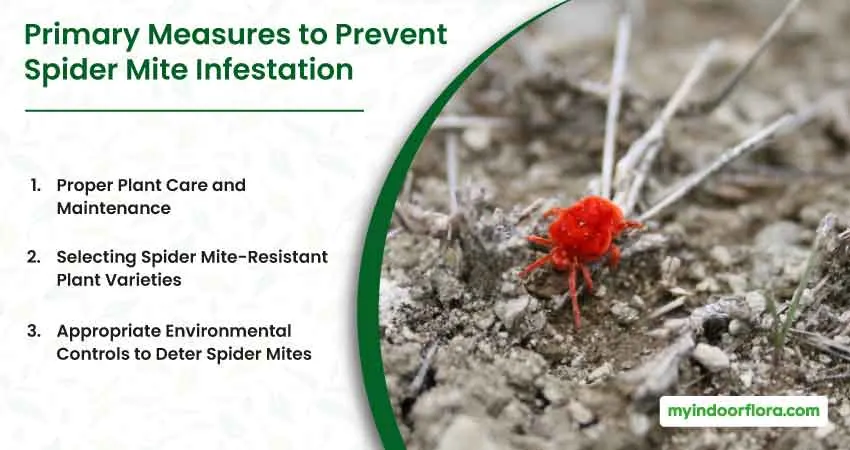
The saying “prevention is better than cure” holds true in the context of spider mites. It’s easier to prevent an infestation than to get rid of one. Let’s delve into the preventive measures.
Proper Plant Care and Maintenance
Healthy plants are less likely to be severely affected by spider mites. Ensure your plants are well cared for – get the lighting, watering, temperature, and humidity right. Avoid over-fertilizing as the mites tend to reproduce faster on plants with high nitrogen levels.
Selecting Spider Mite-Resistant Plant Varieties
Certain plants are less attractive to spider mites. If you’re choosing new plants for your home, consider spider mite-resistant varieties. For instance, plants with thicker leaves like succulents are less susceptible.
Appropriate Environmental Controls to Deter Spider Mites
Remember, spider mites love dry and warm conditions. Regular misting of plants can help maintain humidity levels and deter mites. Also, try to keep temperatures at a moderate level.
Having taken preventive steps, what should you do if you still find your plants infested?
How To Get Rid of Spider Mites from Your Indoor Plants Naturally? (1st Way)
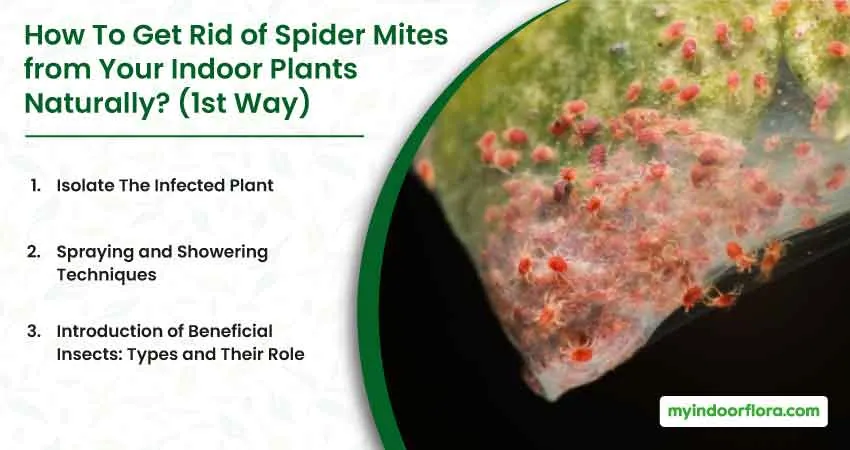
Often, the first instinct is to reach for chemical pesticides. However, these can be harmful to both your plants and your indoor air quality. Let’s look at some natural methods first.
Isolate The Infected Plant
Routinely inspecting your plants is crucial for early detection. Pay close attention to the underside of leaves as spider mites prefer to hide there. If you find any, isolate the infected plant immediately to prevent the mites from spreading.
Spraying and Showering Techniques
A strong jet of water can dislodge mites from your plants. Take the infected plant outside or to your bathtub, and use a sprayer to wash off the mites. Repeat this process every few days to ensure you get any mites that were missed or have newly hatched.
Introduction of Beneficial Insects: Types and Their Role
Certain insects, like ladybugs, predatory mites, and lacewings, are natural predators of spider mites. Introducing these beneficial insects can be an effective and eco-friendly way of controlling infestations.
Ladybugs: The Polka-Dotted Predators
A single ladybug can eat as many as 5,000 aphids in its lifetime, and spider mites are no exception to its appetite. According to the research by the University of Kentucky College of Agriculture, Food, and Environment, ladybugs are one of the most effective natural predators of spider mites. Notably, the species Stethorus punctillum is a specialist predator of spider mites and is used as a biological control agent.
Predatory Mites: Fight Fire with Fire
Predatory mites, such as Phytoseiulus persimilis and Neoseiulus californicus, are some of the most effective biological control agents against spider mites. A study published in Experimental and Applied Acarology journal found that a single Phytoseiulus persimilis could consume around 5-30 spider mites (or 20-200 of their eggs) daily.
Lacewings: The Voracious Green Machines
Known for their delicate, lace-like wings, lacewings (specifically, their larvae known as “aphid lions”) are voracious predators of soft-bodied arthropods, including spider mites. A research published by Cornell University’s College of Agriculture and Life Sciences found that a single lacewing larva can consume up to 200 pests or pest eggs a week.
Introducing Beneficial Insects: Practical Tips
If you decide to introduce beneficial insects to control spider mites, consider these tips for success:
- Identify the Pest: Ensure you’re dealing with spider mites before introducing predatory mites or other beneficial insects.
- Purchase from Reputable Suppliers: Purchase your beneficial insects from reputable suppliers to ensure they’re disease-free and capable of performing their pest control role.
- Release Techniques: Release techniques can vary depending on the insect, so follow the supplier’s recommendations.
- Provide a Suitable Environment: Make sure your garden is a welcoming place for the beneficial insects. This includes avoiding broad-spectrum insecticides which can harm these beneficial insects as well as pests.
Relying on beneficial insects for pest control not only contributes to biodiversity but also helps reduce dependence on chemical pesticides, resulting in healthier plants and a healthier environment.
However, remember, these methods might not always be enough, especially if the infestation is severe.
Effective Home Remedies for Spider Mite Eradication (2nd Way)
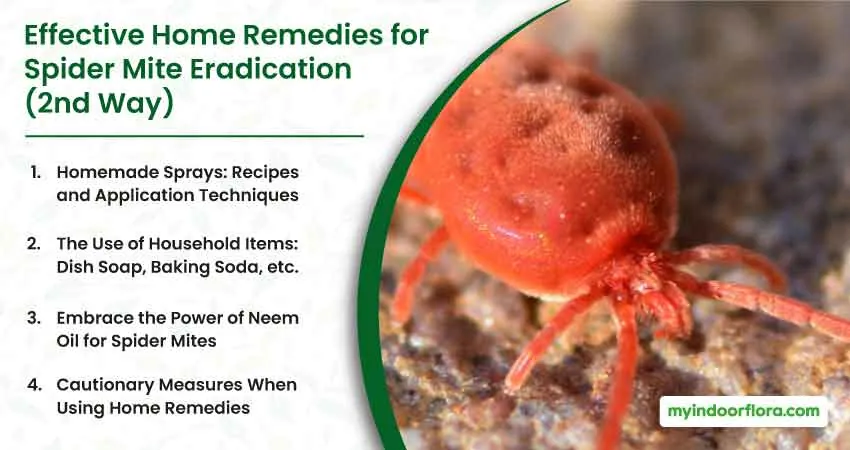
When an infestation is beyond the point of simply washing or brushing off the mites, home remedies can provide the next line of defense. They’re easy, cost-effective, and often surprisingly efficient at mitigating infestations.
Homemade Sprays: Recipes and Application Techniques
Homemade sprays are a valuable tool in combating spider mite invasions. Here are a couple of proven recipes you can whip up in your kitchen.
1. Mild Soap Solution
Ingredients:
- 1 tablespoon of mild liquid soap
- 1 liter of water
Steps:
- Mix the soap and water thoroughly.
- Spray it onto the plant, especially focusing on the underside of the leaves.
The soap solution works by dissolving the mite’s exoskeleton, which leads to dehydration and death.
2. Hot Pepper and Garlic Spray
Ingredients:
- 2 tablespoons of hot pepper sauce
- 4 cloves of garlic
- 1 quart of water
Steps:
- Combine the hot pepper sauce, garlic, and water. Allow it to steep overnight.
- Strain the solution.
- Spray it onto the plants every three days.
The Use of Household Items: Dish Soap, Baking Soda, etc.
Common kitchen supplies, like dish soap and baking soda, can also double as spider mite deterrents.
Dish Soap and Baking Soda Spray
Ingredients:
- 1 teaspoon of baking soda
- A small amount of mild dish soap
- 1 liter of water
Steps:
- Combine the baking soda, dish soap, and water.
- Spray the mixture on the plants.
This blend not only kills the mites but also inhibits their reproductive capabilities.
Embrace the Power of Neem Oil for Spider Mites
Neem oil, extracted from the seeds of the neem tree (Azadirachta indica), is a potent weapon against a myriad of plant pests, including spider mites. Its active component, azadirachtin, interrupts the life cycle of the mites, making it an effective long-term solution to infestations and an excellent preventive measure.
Various research, such as the study published in the Journal of Pest Science, have corroborated the efficacy of neem oil in pest management. It does not immediately kill pests but affects their growth and ability to feed, thereby providing long-term control.
DIY Neem Oil Spray for Spider Mites
Purchasing neem oil concentrate allows you to prepare your spray at home according to your needs. Here’s a recipe you might find useful:
Ingredients:
- 1 1/2 teaspoons of pure neem oil concentrate
- 1 teaspoon of mild liquid soap
- 1 liter of tepid water
Steps:
- Combine the neem oil and soap in a container.
- Gradually add water while stirring continuously.
- Once mixed well, transfer the solution to a spray bottle.
While neem oil is effective, it might take a while to completely eradicate the spider mites. Using neem oil after you’ve washed the leaves and sprayed the plant with insecticidal soap can fast-track the process, offering the best of both immediate and long-term pest control.
Alternatives to Neem Oil: Horticultural Oil and Hot Pepper Wax Spray
If you’re looking for alternatives, pre-mixed horticultural oils or hot pepper wax sprays can also be quite effective. They work by suffocating or repelling the mites, providing a layer of protection to your houseplants.
Horticultural oils work by blocking the air holes (spiracles) through which many pests breathe. Meanwhile, hot pepper wax sprays use capsaicin, the compound that gives hot peppers their heat, as a natural deterrent against pests. Both are eco-friendly alternatives that won’t disrupt your indoor garden’s balance.
Remember, when using any oil or wax-based sprays, ensure your plants are not under stress, and avoid applying during high temperatures to prevent leaf burn. It’s also recommended to test the spray on a small part of the plant before a full application.
Cautionary Measures When Using Home Remedies
While these remedies are natural, they can still damage your plants if not used correctly. Always test a small amount on a portion of the plant first and wait 24-48 hours to check for any adverse reaction. If there’s no harm, you can proceed to spray the entire plant.
Sometimes, even these methods aren’t enough. In such cases, you might have to resort to chemical control.
When Should You Consider Chemical Control for Spider Mites? (3rd Way)
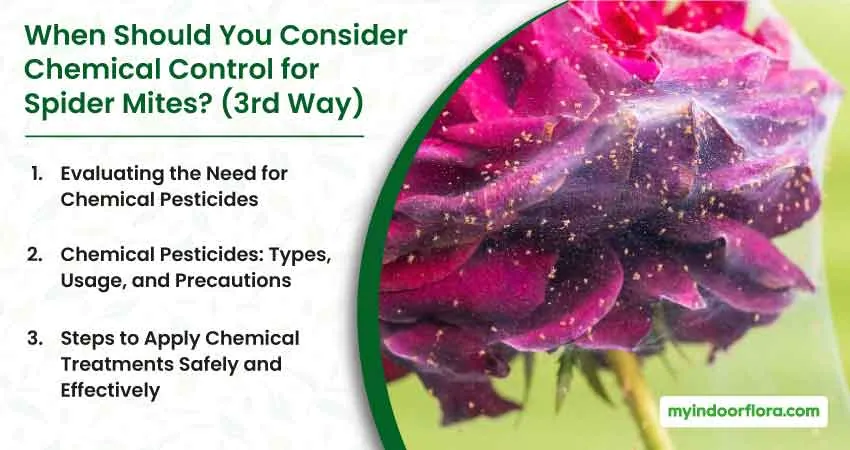
Natural remedies and home concoctions can be quite effective against spider mites, but in some cases, particularly severe infestations, they might fall short. When you’ve exhausted these safer avenues and the infestation continues to thrive, it might be time to consider chemical control. However, it’s crucial to remember that chemical pesticides, while potent, can pose toxicity risks to humans, pets, and non-target organisms.
Evaluating the Need for Chemical Pesticides
In determining whether you need chemical control, consider the following factors:
- Severity of Infestation: If a large proportion of your plants are infested, or if a particular plant is heavily infested, chemical control may be required.
- Effectiveness of Other Methods: If you’ve consistently applied natural remedies and other non-chemical methods, but the mites persist, this might signal a need for stronger action.
- Plant Health: If your plants are visibly suffering and their health is rapidly deteriorating, you might not have the luxury of time for slower-acting treatments.
Chemical Pesticides: Types, Usage, and Precautions
Chemical pesticides are potent tools in the fight against spider mites, working primarily by disrupting the mite’s nervous system, leading to their death. Some common chemical pesticides for spider mites include:
- Avid: This pesticide, containing the active ingredient Abamectin, is effective against various species of mites and other pests.
- Floramite: Floramite, with the active ingredient Bifenazate, is specifically designed to control spider mites.
- Forbid: Forbid, featuring the active ingredient Spiromesifen, is effective against mites at all stages of their lifecycle.
While these pesticides can be effective, they should be used with caution. Always follow the manufacturer’s instructions regarding dosage, application, and safety precautions. Overuse or improper use of these pesticides can lead to mites developing resistance, making future infestations more challenging to control.
Steps to Apply Chemical Treatments Safely and Effectively
Proper application of chemical treatments is as crucial as selecting the right product. Here are some steps to ensure safe and effective application:
- Wear Protective Gear: Always wear gloves, a mask, and protective eyewear when handling and applying pesticides.
- Apply Thoroughly: Cover all plant surfaces, paying special attention to the underside of leaves where mites often reside.
- Isolate Treated Plants: Keep treated plants away from children, pets, and non-target plants until the pesticide has dried completely.
- Rotate Pesticides: To prevent mites from developing resistance, rotate between different types of pesticides if multiple treatments are needed.
- Monitor After Treatment: Keep a close eye on treated plants for signs of continued infestation or pesticide-induced damage.
Chemical control is a potent but risky tool against spider mites. It should be employed judiciously, only when less harmful methods prove ineffective, and always with the utmost care and attention to safety guidelines.
After dealing with an infestation, how can you ensure your indoor plants stay spider mite-free?
Ensure a Spider Mite-Free Environment Post-Eradication
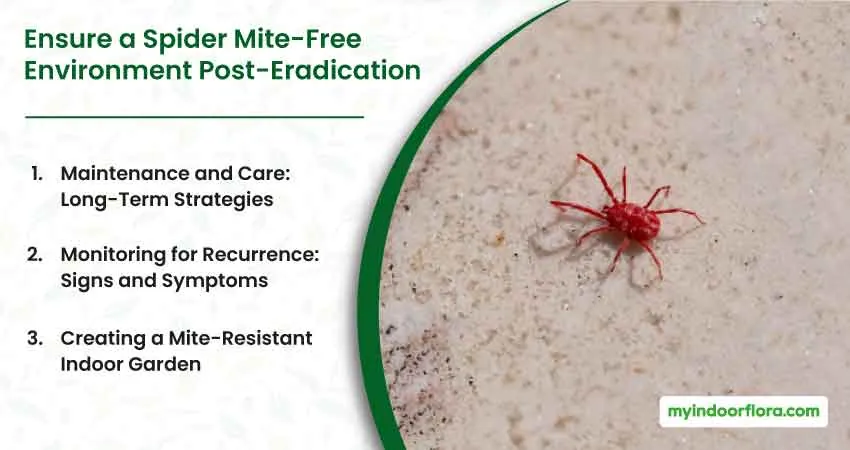
Success in eradicating spider mites calls for celebration, but the battle isn’t over yet. You must ensure they don’t return to wreak havoc on your plants again. Here’s how to make your indoor garden a fortress against mite infestations.
Maintenance and Care: Long-Term Strategies
Your plants’ health is the front line of defense against pests. Ensuring optimal conditions for your plants can significantly reduce the chances of another infestation. Here are some care aspects you need to focus on:
- Watering: Provide consistent and adequate watering based on your plants’ specific needs. Overwatering or underwatering can stress plants, making them more susceptible to pests.
- Fertilizing: Use a balanced, slow-release fertilizer suitable for your plant types. Excessive nitrogen can encourage mite infestations.
- Lighting: Ensure your plants receive the right amount of light. Some plants prefer bright, indirect light while others do well in shade. Inappropriate lighting can weaken your plants and attract pests.
Monitoring for Recurrence: Signs and Symptoms
Vigilance is essential in the weeks following mite treatment. Spider mites can reproduce rapidly, and a small, overlooked population can lead to a full-blown infestation again. Regularly inspect your plants, particularly the underside of leaves, for signs of spider mites. Look out for tiny mites, webbing, or the telltale stippling on leaves.
Creating a Mite-Resistant Indoor Garden
Creating an environment unfavorable to spider mites is your best defense. Here’s how you can do it:
- Control Temperature and Humidity: Spider mites prefer hot, dry conditions. Try to keep the humidity levels high and temperatures lower in your indoor garden. Humidifiers or regular misting can help maintain high humidity.
- Choose Resistant Varieties: Some plants are less susceptible to spider mite infestations. If possible, opt for these varieties when adding to your indoor garden.
- Introduce Beneficial Insects: As discussed earlier, beneficial insects like ladybugs, predatory mites, and lacewings can control spider mite populations.
Nobody wants their plant sanctuary invaded by spider mites. But with diligent care, regular monitoring, and a thoughtful approach to creating a mite-resistant environment, you can enjoy a lush, thriving indoor garden sans these pesky invaders.
Wrapping Up
To conclude, while spider mites are a common pest for indoor plants, with the right knowledge, they don’t have to be a formidable adversary. Understanding the conditions they favor, knowing the early signs of an infestation, and taking swift action can help you control and eliminate these tiny pests.
Preventive care is the cornerstone of keeping your indoor garden mite-free. Regular inspections, optimal plant care, and environmental controls are crucial to creating an environment less inviting to spider mites. And, even if they invade, natural remedies and home solutions can often nip the problem in the bud.
In the case of severe infestations, chemical control can be an effective solution, provided it’s used with caution and in a well-informed manner. Post-eradication, it’s all about vigilance and creating a mite-resistant environment.
Ultimately, nurturing an indoor garden is a rewarding experience. While pests like spider mites can pose challenges, they also teach us more about plant care and the delicate balance of nature. By arming ourselves with knowledge and taking prompt action, we can ensure our indoor gardens continue to be a source of joy and tranquility.
